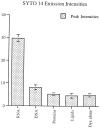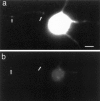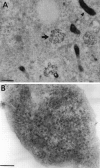Translocation of RNA granules in living neurons
- PMID: 8987809
- PMCID: PMC6579227
- DOI: 10.1523/JNEUROSCI.16-24-07812.1996
Translocation of RNA granules in living neurons
Abstract
Sorting of RNAs to specific subcellular loci occurs in diverse settings from fly oocytes to mammalian neurons. Using the membrane-permeable nucleic acid stain SYTO 14, we directly visualized the translocation of endogenous RNA in living cells. Labeled RNA was distributed nonrandomly as discrete granules in neuronal processes. The labeled granules colocalized with poly(A+) mRNA, with the 60S ribosomal subunit, and with elongation factor 1alpha, suggesting that granules represent a translational unit. A subset of labeled granules colocalized with beta-actin mRNA. Correlative light and electron microscopy indicated that the fluorescent granules corresponded to clusters of ribosomes at the ultrastructural level. Poststaining of sections with heavy metals confirmed the presence of ribosomes within these granules. In living neurons, a subpopulation of RNA granules was motile during the observation period. They moved at an average rate of 0.1 microm/sec. In young cultures their movements were exclusively anterograde, but after 7 d in culture, one-half of the motile granules moved in the retrograde direction. Granules in neurites were delocalized after treatment with microtubule-disrupting drugs. These results raise the possibility of a cellular trafficking system for the targeting of RNA in neurons.
Figures







Similar articles
-
Transport of fragile X mental retardation protein via granules in neurites of PC12 cells.Mol Cell Biol. 2002 Dec;22(23):8332-41. doi: 10.1128/MCB.22.23.8332-8341.2002. Mol Cell Biol. 2002. PMID: 12417734 Free PMC article.
-
A molecular mechanism for mRNA trafficking in neuronal dendrites.J Neurosci. 2003 Oct 1;23(26):8859-66. doi: 10.1523/JNEUROSCI.23-26-08859.2003. J Neurosci. 2003. PMID: 14523087 Free PMC article.
-
Localization of FMRP-associated mRNA granules and requirement of microtubules for activity-dependent trafficking in hippocampal neurons.Genes Brain Behav. 2005 Aug;4(6):350-9. doi: 10.1111/j.1601-183X.2005.00128.x. Genes Brain Behav. 2005. PMID: 16098134
-
Cytoplasmic RNA Granules in Somatic Maintenance.Gerontology. 2018;64(5):485-494. doi: 10.1159/000488759. Epub 2018 May 30. Gerontology. 2018. PMID: 29847814 Review.
-
RNA granules and cytoskeletal links.Biochem Soc Trans. 2014 Aug;42(4):1206-10. doi: 10.1042/BST20140067. Biochem Soc Trans. 2014. PMID: 25110026 Review.
Cited by
-
mRNA on the move: the road to its biological destiny.J Biol Chem. 2013 Jul 12;288(28):20361-8. doi: 10.1074/jbc.R113.452094. Epub 2013 May 28. J Biol Chem. 2013. PMID: 23720759 Free PMC article. Review.
-
Puromycin reveals a distinct conformation of neuronal ribosomes.Proc Natl Acad Sci U S A. 2024 Feb 13;121(7):e2306993121. doi: 10.1073/pnas.2306993121. Epub 2024 Feb 5. Proc Natl Acad Sci U S A. 2024. PMID: 38315848 Free PMC article.
-
Pyrene binary probes for unambiguous detection of mRNA using time-resolved fluorescence spectroscopy.Nucleic Acids Res. 2006 Jun 12;34(10):3161-8. doi: 10.1093/nar/gkl406. Print 2006. Nucleic Acids Res. 2006. PMID: 16769776 Free PMC article.
-
Local Translation in Axons: When Membraneless RNP Granules Meet Membrane-Bound Organelles.Front Mol Biosci. 2019 Nov 22;6:129. doi: 10.3389/fmolb.2019.00129. eCollection 2019. Front Mol Biosci. 2019. PMID: 31824961 Free PMC article. Review.
-
Spatial patterns of the cap-binding complex eIF4F in human melanoma cells.Comput Struct Biotechnol J. 2023 Jan 31;21:1157-1168. doi: 10.1016/j.csbj.2023.01.040. eCollection 2023. Comput Struct Biotechnol J. 2023. PMID: 36789267 Free PMC article.
References
-
- Atkinson S, Doberstein SK, Pollard TD. Moving off the beaten track. Curr Biol. 1992;2:326–328. - PubMed
-
- Banker GA, Waxman AB. Hippocampal neurons generate natural shapes in cell culture. In: Lasek RJ, Black MM, editors. Studies of the intrinsic determinants of neuronal form and function. Liss; New York: 1988. pp. 61–82.
-
- Barbarese E, Koppel DE, Deutscher MP, Smith CL, Ainger K, Morgan F, Carson JH. Protein translation components are colocalized in granules in oligodendrocytes. J Cell Sci. 1995;108:2781–2790. - PubMed
Publication types
MeSH terms
Substances
Grants and funding
LinkOut - more resources
Full Text Sources
Other Literature Sources
